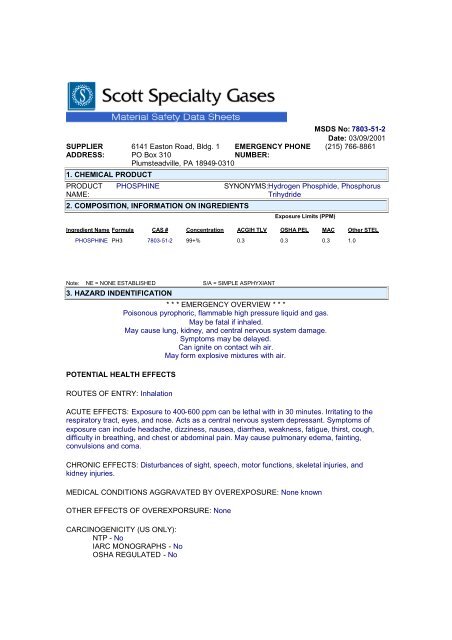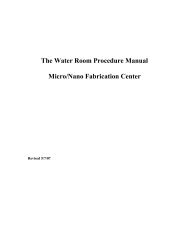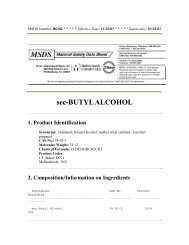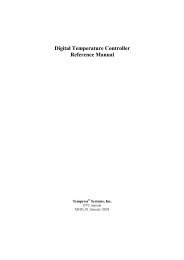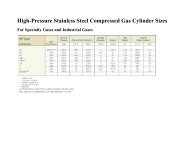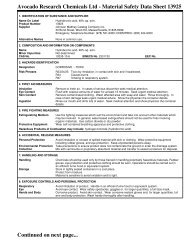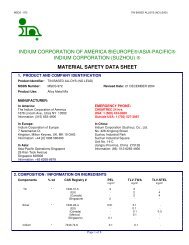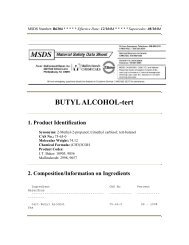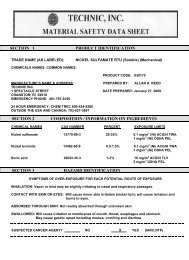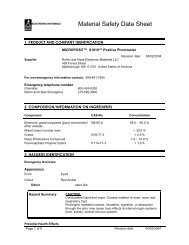MSDS No: 7803-51-2 Date: 03/09/2001 SUPPLIER ADDRESS ...
MSDS No: 7803-51-2 Date: 03/09/2001 SUPPLIER ADDRESS ...
MSDS No: 7803-51-2 Date: 03/09/2001 SUPPLIER ADDRESS ...
Create successful ePaper yourself
Turn your PDF publications into a flip-book with our unique Google optimized e-Paper software.
<strong>SUPPLIER</strong><br />
<strong>ADDRESS</strong>:<br />
1. CHEMICAL PRODUCT<br />
PRODUCT<br />
NAME:<br />
6141 Easton Road, Bldg. 1 EMERGENCY PHONE<br />
<strong>MSDS</strong> <strong>No</strong>: <strong>78<strong>03</strong></strong>-<strong>51</strong>-2<br />
<strong>Date</strong>: <strong>03</strong>/<strong>09</strong>/<strong>2001</strong><br />
(215) 766-8861<br />
PO Box 310<br />
Plumsteadville, PA 18949-<strong>03</strong>10<br />
NUMBER:<br />
PHOSPHINE SYNONYMS:Hydrogen Phosphide, Phosphorus<br />
Trihydride<br />
2. COMPOSITION, INFORMATION ON INGREDIENTS<br />
Exposure Limits (PPM)<br />
Ingredient Name Formula CAS # Concentration ACGIH TLV OSHA PEL MAC Other STEL<br />
PHOSPHINE PH3 <strong>78<strong>03</strong></strong>-<strong>51</strong>-2 99+% 0.3 0.3 0.3 1.0<br />
<strong>No</strong>te: NE = NONE ESTABLISHED S/A = SIMPLE ASPHYXIANT<br />
3. HAZARD INDENTIFICATION<br />
POTENTIAL HEALTH EFFECTS<br />
ROUTES OF ENTRY: Inhalation<br />
* * * EMERGENCY OVERVIEW * * *<br />
Poisonous pyrophoric, flammable high pressure liquid and gas.<br />
May be fatal if inhaled.<br />
May cause lung, kidney, and central nervous system damage.<br />
Symptoms may be delayed.<br />
Can ignite on contact wih air.<br />
May form explosive mixtures with air.<br />
ACUTE EFFECTS: Exposure to 400-600 ppm can be lethal with in 30 minutes. Irritating to the<br />
respiratory tract, eyes, and nose. Acts as a central nervous system depressant. Symptoms of<br />
exposure can include headache, dizziness, nausea, diarrhea, weakness, fatigue, thirst, cough,<br />
difficulty in breathing, and chest or abdominal pain. May cause pulmonary edema, fainting,<br />
convulsions and coma.<br />
CHRONIC EFFECTS: Disturbances of sight, speech, motor functions, skeletal injuries, and<br />
kidney injuries.<br />
MEDICAL CONDITIONS AGGRAVATED BY OVEREXPOSURE: <strong>No</strong>ne known<br />
OTHER EFFECTS OF OVEREXPORSURE: <strong>No</strong>ne<br />
CARCINOGENICITY (US ONLY):<br />
NTP - <strong>No</strong><br />
IARC MONOGRAPHS - <strong>No</strong><br />
OSHA REGULATED - <strong>No</strong>
4. FIRST AID MEASURES<br />
INHALATION: Immediately remove victim to fresh air. If breathing has stopped, give artificial<br />
respiration. If breathing is difficult, give oxygen.<br />
EYE CONTACT: Immediately flush with copious amounts of water for at least 15 minutes.<br />
SKIN CONTACT: Immediately flush with copious amounts of water for at least 15 minutes while<br />
removing contaminated clothing.<br />
INGESTION: <strong>No</strong>ne<br />
IN EVENT OF EXPOSURE, CONSULT A PHYSICIAN<br />
NOTE TO PHYSICIAN: Victim should be retained for observation. Signs and symptoms of<br />
pulmonary edema can be delayed for several hours.<br />
5. FIRE FIGHTING MEASURES<br />
FLASH POINT: Spontaneously flammable in air.<br />
AUTOIGNITION TEMPERATURE: 100 deg. C<br />
FLAMMABLE LIMITS: Vol.% in air<br />
LOWER: 1.6<br />
UPPER: 98<br />
EXTINGUISHING MEDIA: Do not extinguish burning gas if flow cannot be shut off immediately.<br />
Use flooding quanity of water as a spray.<br />
SPECIAL FIRE FIGHTING INSTRUCTION AND EQUIPMENT: Wear self-contained breathing<br />
apparatus and full protective clothing. Keep fire exposed cylinders cool with water spray. If<br />
possible, stop the product flow.<br />
HAZARDOUS COMBUSTION PRODUCTS: Phosphine emits phosphoric acid and hydrogen.<br />
UNUSUAL FIRE AND EXPLOSION HAZARDS: Emits toxic fumes under fire conditions.<br />
Moderate hazard when exposed to heat or flame. Cylinder rupture may occur under fire<br />
conditions. Do not extinguish unless gas flow can be stopped. Otherwise, escaping gas may reignite<br />
without warning.<br />
6. ACCIDENTAL RELEASE MEASURES<br />
CLEAN UP PROCEDURES: Evacuate and ventilate area. Remove sources of ignition and<br />
combustibles. Allow gas to vent if flow cannot be stopped.<br />
SPECIALIZED EQUIPMENT: <strong>No</strong>ne<br />
7. HANDLING AND STORAGE
PRECAUTIONS TO BE TAKEN IN HANDLING: Secure cylinder when using to protect from<br />
falling. Use suitable hand truck to move cylinders.<br />
PRECAUTIONS TO BE TAKEN IN STORAGE: Store in well ventilated areas. Keep valve<br />
protection cap on cylinders when not in use.<br />
8. EXPOSURE CONTROLS / PERSONAL PROTECTION<br />
ENGINEERING CONTROLS: Provide adequate general and local exhaust ventilation to maintain<br />
concentration below exposure limits.<br />
EYE / FACE PROTECTION: Safety glasses<br />
SKIN PROTECTION: <strong>No</strong>ne<br />
RESPIRATORY PROTECTION: In case of leakage, use self-contained breathing apparatus.<br />
OTHER PROTECTIVE EQUIPMENT: Safety shoes when handling cylinders.<br />
9. PHYSICAL AND CHEMICAL PROPERTIES<br />
APPEARANCE: Colorless<br />
ODOR: Garlic like odor.<br />
PHYSICAL PRESSURE: Gas<br />
VAPOR PRESSURE: N/Ap<br />
VAPOR DENSITY (AIR=1): 1.17<br />
BOILING POINT (C): -87.7<br />
SOLUBILITY IN WATER: Slight<br />
SPECIFIC GRAVITY (H2O=1): 1.18<br />
EVAPORATION RATE: N/Ap<br />
ODOR THRESHOLD: N/Av<br />
10. STABILITY AND REACTIVITY<br />
STABILITY: Stable under normal storage conditions.<br />
CONDITIONS TO AVOID: Storage in poorly ventilated areas. Storage near a heat source.<br />
Contact with air.<br />
MATERIALS TO AVOID: Oxidants such as oxygen and chlorine. Avoid copper, silver,
magnesium, mercury, and their salts.<br />
HAZARDOUS POLYMERIZATION: Will not occur.<br />
HAZARDOUS DECOMPOSITION: Phosphine emits phosphorous, POx, phosphoric acid.<br />
Hydrogen gas.<br />
11. TOXICOLOGICAL INFORMATION<br />
LETHAL CONCENTRATION (LC50): 20 ppm, rat 1 hour.<br />
LETHAL DOSE 50 (LD50): N/Ap<br />
TERATOGENICITY: N/Ap<br />
REPRODUCTIVE EFFECTS: N/Ap<br />
MUTAGENICITY: N/Ap<br />
12. ECOLOGICAL INFORMATION<br />
<strong>No</strong> adverse ecological effects are expected.<br />
13. DISPOSAL CONSIDERATIONS<br />
WASTE DISPOSAL METHOD: Dispose of non-refillable cylinders in accordance with federal,<br />
state and local regulations. Allow gas to vent slowly to atmosphere in an unconfined area or<br />
exhaust hood. If the cylinders are the refillable type, return cylinders to supplier with any valve<br />
outlet plugs or caps secured and valve protection caps in place.<br />
14. TRANSPORT INFORMATION<br />
CONCENTRATION: 99+%<br />
DOT DESCRIPTION (US ONLY):<br />
PROPER SHIPPING NAME: Phosphine<br />
HAZARD CLASS: 2.3 (poison), Hazard Zone A<br />
INDENTIFICATION NUMBER: UN2199<br />
REPORTABLE QUANTITIES: N/Av<br />
LABELING: POISON GAS, FLAMMABLE GAS<br />
ADR / RID (EU Only): Class 2, 1TF<br />
SPECIAL PRECAUTIONS: Cylinders should be transported in a secure upright position in a well<br />
ventilated truck.
15. REGULATORY INFORMATION<br />
OSHA: Process Safety Management: Material is not listed in appendix A of 29 CFR 1910.119 as<br />
highly hazardous chemical.<br />
TSCA: Material is listed in TSCA inventory.<br />
SARA: The threshold planning quantity for this material is 500 lb.<br />
EU NUMBER: 232-260-8<br />
NUMBER IN ANNEX 1 OF DIR 67/548: Material is listed in annex 1.<br />
EU CLASSIFICATION: N/Av<br />
R: N/Av<br />
S: N/Av<br />
16. OTHER INFORMATION<br />
OTHER PRECAUTIONS: Protect containers from physical damage. Do not deface cylinders or<br />
labels. Cylinders should be refilled by qualified producers of compressed gas. Shipment of a<br />
compressed gas cylinder which has not been filled by the owner or with his written consent is a<br />
violation of federal law (49 CFR).<br />
ABBREVIATIONS: N/Ap - <strong>No</strong>t Applicable N/Av - <strong>No</strong>t Available SA - Simple Asphyxiant NE - <strong>No</strong>ne<br />
Established<br />
DISCLAIMER: Information included in this document is given to the best of our knowledge,<br />
however, no warranty is made that the information is accurate or complete. We do not accept any<br />
responsibility for damages by the use of the document.


